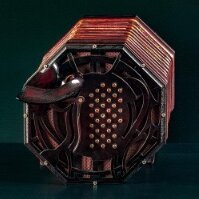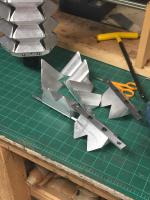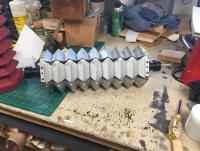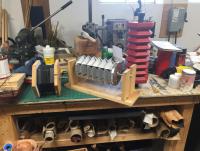Search the Community
Showing results for tags 'construction'.
-
This will be a rather long post, but I hope it won't scare any of you off:) I'm asking this questions hoping that one of you, concertina builders, could give me some general advices and directions on making my own instrument... I don't expect you to share "secrets of the trade" with me - I'm hoping for general "been there, done that, it does/doesn't work" answers and some general knowlege. I've read what I could find on this forum (and on Bob Tedrow site) on concertina building, but I'm still wondering on a few things.. The basic goal of this project is to build a Hayden duet with a range of a typical button accordion, as my desired repertoire consist mostly of conterporary accordion, klezmer, balkan and rock music. I now own an Elise, which being a great entry-level instrument has reached its limits and purchasing larger instrument is not an option because of two main reasons: first - range of available instruments (even Wakker H-2, Tedrow layout, and discussed elswere on this forum hypothetical Morse maximum layout do not fit my needs). And second - prices which, as reasonable as they are, are sadly far from reach for central european wages... I have a quite large set of DIY skills, including metal machining (from stop-motion animation armature making) and both large and small scale woodworking. As for the project itself - as I see it, it will be a hybrid instrument, with reeds scrapped from russian button accordion. I plan on building reedpan and action board first (with a final quality) and put it into a mocked up, prototype but playable case and then build final instrument gradually around it. It will have a normal single reed per note, riveted action aluminum buttons (same as in the modification of the Elise I own) with brass levers, will probably be square (to be as small as possible) and with leather bellows (in its final form - for the protype phase I plan on modifying an accordion bellows). Now, finally for specific questions: a) I wish to obtain as mellow, concertina like, sound as possible with accordion reeds. I have made some experiments to understand how different materials and fretwork pattern/fretless design affect sound. As for other factors to consider in modifying sound, can any of you make a sorted list of them, in order from the most influential to the least? (Except for proper concertina reeds of course:)) As far as I can see, the hybrid reed chambers of modern concertinas are mostly the size of a reed shoe and "cubical" in shape. But accordion reed blocks are trapezoid in shape and often have inserts in them to further change the volume and shape of the reed chamber. Can someone explain to me how these differences affect sound and reed response (in general - again, I don't expect you to give me equations, rather answers what makes reeds slower/faster to speak and sound more mellow/bright) c) I know that using reedpan or reedblocks affect the sound considerably. Is it because of the airflow direction (straight vs "cornered") or sound reflection inside of the a reed chamber? As far as I know, reed instruments don't base on resonant qualities of wood - does a single reedpan affect the sound on any other basis than airflow direction/number of sound bounces in reed chamber (e.g thickness and mass of woodblock etc)? c') As I can see on the only available picture, accordeaphone had a mix of reedpan and an accordion style reedblocks. Have any of you tried "layering" reedpans? It's a little hard to explain what I mean, but what I have in mind would allow overlaying reeds by as much as half of the lenght of the reed shoe and fit reeds in smaller box at a cost of thicker concertina ends (same as when using accordion-style reedblocks). Would such layered reedpan retain the concertina characteristic of sound? ( for some reeds air would have to travel twice as far between reed and valve/lever) d) Does method of mounting reeds to the reed pan affect sound? I'm asking whether wax, wedge mount or L-screw have different stiffnes thus afecting sound in any significant way? If you could spare a moment and answer some of those questions I would be thankfull. PS.: please forgive me any mistakes, english is not my native language...
- 78 replies
-
- Construction
- Building
-
(and 2 more)
Tagged with:
-
I haven't been here for a while but have an urge to start a project I've been thinking about. I have several cheap concertinas, including a cheap, common, Stagi/Bastari 20 button Anglo that had the average sticking buttons problem when I bought it off of E-bay. I've been wondering if I could do anything to improve the design and the way that it plays. I have access to a very nice wood shop and have done some woodworking in my spare time, including some woodcarving. I also have access to a jewelry shop where I work with and cast metal and I have plenty of jewelry files, saws, and shaping equipment. Last, but not least, I have access to a nice CNC laser and I've already drawn up a computer drawing for an alternate cover for the 20 button. I'm thinking my first step at learning about concertina work should be replacing the plywood covers with some nice hardwood. Maybe maple or walnut. Cherry if I can find a big enough piece in the scrap bin. Does anyone have any suggestions? Incidently, when I first started coming here I was at first overjoyed to find that I lived near Mr. Herrington in Rowlett, TX, but then saddened to find he had passed away a few months before my first visit to this site. He sounds like a great guy and I would have loved to have met him. Terrence in Terrell, TX
- 15 replies
-
- construction
- design
-
(and 1 more)
Tagged with:
-
Many years ago I visited Steve Dickenson's shop. While I have used the core or tube type bellows forms for odd sized or non hexagonal bellows, I much prefer these molds which are a close approximation of what he used from the old Wheatstone factory. They are not difficult to make out of wood, though I impregnated my one wooden version with wax to keep glue from sticking. They are meant to be used with the bellows frames mounted and an integral part of the bellows making process. The aluminum versions are great if you are making a lot of bellows. Steve's aluminum versions were cast metal, I just milled mine from bar stock 6063 aluminum, and precipitation hardened them in my baking oven. The bars swing to the empty center and are pulled out the ends when finished. I recently split them and added inserts to do 5, 6, 7 or 8 fold bellows. Steve's had small central wooden cores that had a channel down the center of each side that a bar on the mold sides fit into. I just put a short section of core on the end plates to keep everything alligned. The clamps for the finished bellows are two parts, one interior set (not visible) to compress the inner folds (Chris Ghent mentions this). And the end pieces to compress the peaks. . Dana
- 10 replies
-
- bellows making
- construction
-
(and 1 more)
Tagged with:
-
This probably seems a silly question to many here, but apart from differences in sound, what are the physical differences between traditional concertina reeds and accordion reeds (in a concertina). Is it just a difference of material, or a different process in making them? How come builders of concertinas didn't stick with the old style reeds? Sorry in advance if some sort of war is created from this question, I'm just intrigued! I love the sound of both types of reed!
-
Hey! I'm new here and a very wet being the ears player, I've been learning anglo for nearly a year now on a secondhand scholer (cue sounds of fainted bodies hitting the floor), but am absolutely in love with this instrument, and harbouring a bit of a silly pipedream about learning to build or at least repair them one day. It seems a bti of a difficult world to get into though, Does anybody have any advice on how I might get into learning short of travelling to Castelfidardo for some years? I live in north wales now and the nearest concertina maker seems to be in Newport. I am trying to learn a few thigns just by messing about with the ones I have (sort of a necessity when it breaks every month nowadays), but since I think they are built differently to most concertinas I guess that's not much use. Any advice? Do apprenticeships run anywhere? Google's brought up nothing.
- 6 replies
-
- construction
- repair
-
(and 1 more)
Tagged with:
-
As I'm looking at changing careers, several of the jobs I'm looking at would involve traveling between very different climates. If I do get one of these heavily-traveling jobs, I was thinking to get a small 20 or 22 button hybrid Anglo so I could leave my vintage Anglo safe at home. Maybe not quite a miniature, but perhaps something like the 21b Marcus Traveller [sic] which is 5" across the flats. I recall having read (maybe in one of Dan's books) that some nicer English concertinas were made for customers stationed in tropical British colonies, so the construction choices were made to resist corrosion, swelling, cracking, etc. If one were to order a small hybrid that's durable for travel, not so much in terms of getting knocked around, but in terms of not as inclined to suffer from heat or humidity, or lack thereof, what kind of features could be reasonably included? Any particular woods more resistant to climate? Any type of bellows construction more resistant to getting soggy from the air? Is there anything to be done at all with reed selection to pick the more rust-resistant option? Screwed-in vice waxed-in reeds? Despite assurances of waxes with high melt points. In terms of having fewer small bits to break, maintaining structural integrity and all that, there must be more conservative ways of doing the fretwork rather than the normal intricate twistiness. Either maybe just some separated round holes like some early German concertinas, or maybe even "fretless" ends like Tedrow builds, where the soundholes are instead openings around the side of the flats. (photo, and a prior thread on fretless)
-
The cheap concertinas that I have (old Bastari) are made using plywood. I don't have the idea that using a different wood would have any appreciable change in the sound on them, but does the wood on the better concertinas have any affect on the sound? I seem to remember noticing that the reed plate in one of the pictures seemed to be beech. Does type of wood have as much difference on a concertina as it does in a guitar or a violin? Terrence PS. I just found the thread from 2006 discussing tonewoods. Additional information, though, would be welcome.
-
- construction
- repair
-
(and 2 more)
Tagged with:
-
Once upon a time in the 80's I had my first computer and modem and had my first taste of a computer network. I had to choose an internet name for myself. "Tinkerer" is what I picked because that was what I was. I tinkered with my computer, in fact, built it myself from an assortment of cast off computer parts and swap meet pieces. I'd been tinkering with everything all my life, from the time I took my toy telescope apart to my current job repairing electronic equipment and I've done pretty well with it. Now I find myself wanting to take my concertina apart. I'm not crazy, I don't plan on taking an expensive Wheatstone or Lachenal apart. Instead I have a couple of cheap second hand buys from Ebay coming, a Scholer and what I think is a relabeled Bastari. I'm hoping for some guidance from one of the books available on concertina construction and repair. There are two available. The Concertina Maintenace Manual by David Elliott and another available from Lark in the Morning. Does anyone have any opinion on which might be better for the concertinas that I mentioned?








